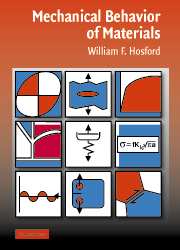Book contents
- Frontmatter
- Contents
- Preface
- Note to the Reader
- 1 Stress and Strain
- 2 Elasticity
- 3 Tensile Testing
- 4 Other Tests of Plastic Behavior
- 5 Strain-Hardening of Metals
- 6 Plasticity Theory
- 7 Strain-Rate and Temperature Dependence of Flow Stress
- 8 Slip
- 9 Dislocation Geometry and Energy
- 10 Dislocation Mechanics
- 11 Mechanical Twinning and Martensitic Shear
- 12 Hardening Mechanisms in Metals
- 13 Ductility and Fracture
- 14 Fracture Mechanics
- 15 Viscoelasticity
- 16 Creep and Stress Rupture
- 17 Fatigue
- 18 Residual Stresses
- 19 Ceramics and Glasses
- 20 Polymers
- 21 Composites
- 22 Mechanical Working
- Appendix A Miller Indices
- Appendix B Stereographic Representation of Orientations
- Index
12 - Hardening Mechanisms in Metals
Published online by Cambridge University Press: 05 June 2012
- Frontmatter
- Contents
- Preface
- Note to the Reader
- 1 Stress and Strain
- 2 Elasticity
- 3 Tensile Testing
- 4 Other Tests of Plastic Behavior
- 5 Strain-Hardening of Metals
- 6 Plasticity Theory
- 7 Strain-Rate and Temperature Dependence of Flow Stress
- 8 Slip
- 9 Dislocation Geometry and Energy
- 10 Dislocation Mechanics
- 11 Mechanical Twinning and Martensitic Shear
- 12 Hardening Mechanisms in Metals
- 13 Ductility and Fracture
- 14 Fracture Mechanics
- 15 Viscoelasticity
- 16 Creep and Stress Rupture
- 17 Fatigue
- 18 Residual Stresses
- 19 Ceramics and Glasses
- 20 Polymers
- 21 Composites
- 22 Mechanical Working
- Appendix A Miller Indices
- Appendix B Stereographic Representation of Orientations
- Index
Summary
Introduction
The strengths of metals are sensitive to microstructure. Most hardening mechanisms involve making dislocation motion more difficult. These mechanisms include decreased grain size, strain-hardening, solid-solution hardening, and dispersion of fine particles. With finer grain sizes there are more grain boundaries to impede dislocation motion. Metals strain-harden because deformation increases the number of dislocations and each interferes with the movement of others. In solid solutions, solute atoms disrupt the periodicity of the lattice. Fine dispersions of hard particles create obstacles to dislocation motion. Martensite formation and strain aging in steels are sometimes considered separate mechanisms, but both are related to the effects of interstitial solutes on dislocations.
Other factors affecting strength are constraints from neighboring grains, preferred orientations, and crystal structure. This chapter will review all of these mechanisms.
Deformation of polycrystals
In polycrystalline materials, each grain is surrounded by others and must deform in such a way that its change of shape is compatible with its neighbors. Slip on a single system within a grain will not satisfy the need for compatibility. Early attempts to calculate the stress–strain behavior of polycrystals by averaging the stresses to cause single slip in each grain did not meet with success. G. I. Taylor achieved much better agreement by assuming that each grain of a polycrystal undergoes the same shape change (set of strains) as the whole polycrystal.
- Type
- Chapter
- Information
- Mechanical Behavior of Materials , pp. 188 - 209Publisher: Cambridge University PressPrint publication year: 2005
- 3
- Cited by



